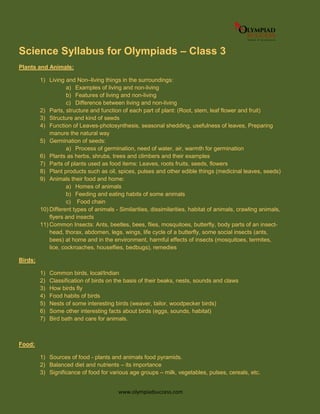
Science Syllabus for Olympiads - Class 3
- 1. www.olympiadsuccess.com Science Syllabus for Olympiads – Class 3 Plants and Animals: 1) Living and Non–living things in the surroundings: a) Examples of living and non-living b) Features of living and non-living c) Difference between living and non-living 2) Parts, structure and function of each part of plant: (Root, stem, leaf flower and fruit) 3) Structure and kind of seeds 4) Function of Leaves-photosynthesis, seasonal shedding, usefulness of leaves, Preparing manure the natural way 5) Germination of seeds: a) Process of germination, need of water, air, warmth for germination 6) Plants as herbs, shrubs, trees and climbers and their examples 7) Parts of plants used as food items: Leaves, roots fruits, seeds, flowers 8) Plant products such as oil, spices, pulses and other edible things (medicinal leaves, seeds) 9) Animals their food and home: a) Homes of animals b) Feeding and eating habits of some animals c) Food chain 10) Different types of animals - Similarities, dissimilarities, habitat of animals, crawling animals, flyers and insects 11) Common Insects: Ants, beetles, bees, flies, mosquitoes, butterfly, body parts of an insect- head, thorax, abdomen, legs, wings, life cycle of a butterfly, some social insects (ants, bees) at home and in the environment, harmful effects of insects (mosquitoes, termites, lice, cockroaches, houseflies, bedbugs), remedies Birds: 1) Common birds, local/Indian 2) Classification of birds on the basis of their beaks, nests, sounds and claws 3) How birds fly 4) Food habits of birds 5) Nests of some interesting birds (weaver, tailor, woodpecker birds) 6) Some other interesting facts about birds (eggs, sounds, habitat) 7) Bird bath and care for animals. Food: 1) Sources of food - plants and animals food pyramids. 2) Balanced diet and nutrients – its importance 3) Significance of food for various age groups – milk, vegetables, pulses, cereals, etc.
- 2. www.olympiadsuccess.com Housing and Clothing: 1) Features of good house and clean house 2) Fibres: Natural fibre, Plant fibre, animal fibre, man-made fibre 3) Clothes and seasons Transport and Communication: 1) Identifying different parts of a vehicle 2) Example of force and motion in our daily life – push, pull 3) Inventions in the field of Science and Technology related to communication 4) Fuel and its use Human Body: 1) Internal organs of the human body: General structure, location and functions of the different internal organs 2) External organs of the human body 3) Respiratory system: a) Parts/organs of the respiratory system, (nose, windpipe, lungs) and their functions, process (inhale & exhale) of breathing b) Diagram and labelling of organs of the respiratory system c) Simple process of deep breathing d) Working model of the respiratory system 4) What is our body made up of? 5) Organ systems a) Skeletal system b) Muscular system c) Digestive system d) Breathing system e) Circulatory system f) Nervous system g) Excretory system h) Reproductive system 6) Air Pollution - Causes and problems 7) Description of sense organs 8) Diseases and symptoms Earth and Universe: 1) Understanding Space – comets, meteors and asteroids 2) Effects of global warming on the earth
- 3. www.olympiadsuccess.com 3) Earth: a) Shape of the earth b) Movements of the earth: Rotation and revolution c) Earth as a magnet 4) The heavenly bodies a) The sun and its family b) Moon: Phases of moon, Surface of the moon c) Stars d) Constellations 5) Why do planets appear bright? 6) What makes life possible on Earth? 7) How are days and nights formed? Matter and Material: 1) Forms of Matter: Solids liquids and gases a) Examples of solids and their properties b) Examples of liquids and their properties c) Examples of gases and their properties d) Uses of matter 2) Change of state Light, Sound and Force: 1) Luminous and non-luminous objects 2) Shadow: Length of shadow 3) Sound 4) Noise 5) Force: Friction, gravitation, muscular, etc. Our Environment: 1) Importance of rain and rain water harvesting 2) Three forms of water, condensation and evaporation. a) Water Purification b) Water cycle 3) Seasons 4) Weather: Windy days, Cloudy days, Rainy days, Sunny days 5) Water impurities: types and causes 6) What does air contain? 7) Physical Properties of water (occupy space, take shape of the container) 8) Water and water solutions: Conditions that affect making of a solution (stirring, warm water).
- 4. www.olympiadsuccess.com 9) Common soluble and insoluble substances in water (simple experiments): Objects that float, sink in water (through simple activities) 10) How is soil formed? 11) Layers and uses of soil 12) What does soil contain? 13) Types of soil: Sandy soil, clayey soil, loam
